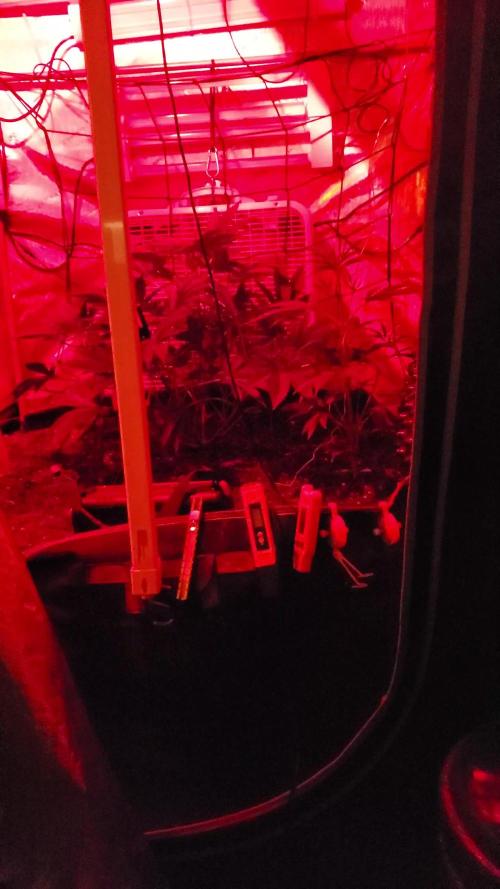By continuing to use the website or clicking Accept you consent to our cookies and personal data policy and confirm that you are at least 18 year old. For details please see Privacy Policy and Terms
Accept
Likes
Comments
Share


@MindFlowers68
Follow
It was the last week for the Black Jack and I was kind of sad to cut it down. I wanted to go the full 9 weeks of flower but she was telling me she was ready. I couldn't wait another week to get the Liberty Haze in its place either. It took an hour just to cut down/hang and remove most of the crispy and yellow leaves. Have a 3x3 set up for drying and have it dialed in and filled it with 5 hangers from the plant. Cut it into chunks as big as i could fit on the hangers. I weighed the buds wet this time just to get an idea of how much they loose during drying. She got light dose if Buddha bloom and some brix/molasses this week as she was starving.l'm still learning when to harvest but I like a more heady high so Its sometimes hard to tell when the trichomes are past my preference but I want to let a plant flower a week or two after its "supposed" to really have a gauge on it.l next time. But i think I hit it at a good time. Will update the harvest soon. I think this one will need the full 2 weeks drying even though I have my dry tent in the basement now instead if my garage with ac/heater It stays about 64 in the basement and i was having a hard time keeping it down to 60 anyway out my studio without the heater and ac constantly battling, and the ac freezing over. I forgot to take pictures of it on the racks and the setup but i will update
Likes
8
Share


@Mennowitsch93
Follow
Blüte Woche 8 es wird gespült bei 4 Ladys seit 2 Tagen und und die anderen zwei vom gleichen Schwung sind die Tage dran.
Likes
8
Share


@High_Grade_Dadli
Follow
All love so far girls are beginning to fatten and scent it getting a bit louder without touch...#happy growing
Likes
1
Share


@Ninjabuds
Follow
ELUFAH DISCOUNT CODE(Amazon): NINJABUDS
GROWACE.COM DISCOUNT CODE (air cube only): NINJABUDS
I'm super stoked to start these new grow diaries! I'll be testing out the Air Cube system, which I got for free – can't wait to see how it works. I've heard good things about it, so I'm excited to put it to the test.
For lighting, I'll be using the ELUFAH UAP 1200. This is a powerful light, so I'm expecting some great results. I'm planning on documenting the whole process, from seed to harvest. It's gonna be a fun experiment!
I'll be posting regular updates, so stay tuned to see how things progress. I'm always open to feedback and suggestions, so feel free to leave a comment!
Don’t forget to tune into my YouTube page for more content about these diaries.
I will be starting these seeds soon stay tuned
Likes
23
Share


@HomeGrownFamz
Follow
A new light has been added to the tent. I noticed a bit of a droop for several hours after adding it. After 4 hours they started picking up again.
They are quite healthy and seem to be very happy.
PH Is around 6.0. It just seems easier to keep it around 6.0. The PH seems to rise to 6 a day after correcting it down to 5.7 so I gave up.
PPM is around 1000 and cal mag is being added to help them cope with the higher light intensity during flower.
Pk13/14 has been added in a very small amount and a slightly higher does will be used in the next week.
Please feel free to comment if you have any info that may help :) please take time to like as it helps me know if this is worthwhile updating.
Microgrowery
Likes
34
Share


@Brick_Bazuha
Follow
Неделя прошла вроде бы хорошо, поливаю сейчас чисто водой, довольная, правда медленно медленно стала цвести, ну ничего пахнет и выглядет всё краше и краше)
Likes
91
Share


@Salokin
Follow
Hi Growmies,
I'm excited to share some big news today! Although there have been some unexpected twists, it's all part of the incredible journey of gardening.
I've just completed the harvest, a tad earlier than initially planned, due to finding a bit of mold in one of the buds. Despite this minor hiccup, the trichomes were already at a decent 10% to 15% amber. So, all things considered, the timing ended up being pretty spot-on. The harvested weight was a solid 609 grams after trimming, which is quite a feat!
A lesson learned for next time: perhaps I let her grow a few too many buds, leading to a denser canopy than ideal. But on the bright side, the aroma is absolutely divine. I sampled an airy bud that had dried a bit, and wow, it packs a stronger punch than its clone mother. And the flavor? Pure, unadulterated cheese – no hint of pineapple here!
Now, the anticipation builds for the final dry weight, which I should know in about 3-4 days. It's always exciting to see the fruits of our labor fully realized.
A huge thanks to everyone who's been following along on this journey. Your interest and support mean the world.
And now, the adventure continues! I've started on Epic Buzz by Anesia Seeds. The diary for this new chapter is up and running, and the seedlings have already sprouted, marking the beginning of another exciting phase.
(https://growdiaries.woodroom.tel/diaries/185718-grow-journal-by-salokin)
I can't wait to share more updates with you all. Here's to the continued growth and learning in our gardening adventures!
Likes
11
Share


@Paradox_1ste1
Follow
First time growing these Ayahuasca Purple. When i saw it first i liked it as a plant and as a bud in the end of the grow and i think and really hope i get really good results from it. If anyone has any tips for me i would be to happy to follow so i can improve the grow better. 🤞
Likes
12
Share


@PedroAndHisPlants
Follow
My first grow has been a great learning experience, and I couldn’t be happier with the results. From the reliable BioBizz soil and nutrients to the impressive performance of the Spider Farmer SF 1000, everything worked well together. Each component contributed to a successful harvest, and I’m excited to continue experimenting and improving my setup with new gear and techniques.💚
Processing
Likes
142
Share


@MadeInGermany
Follow
Hi everyone :-)
This week the buds developed super ;-) All are beautiful 😍.
Super genetics 👍.
Blue Cheese pheno 1 is slowly coming to an end :-)
This week I will start to use up the remaining nutrients and harvest in 10-14 days ;-)
Everyone else needs something else :-) have fun with the videos, stay healthy 🙏🏻 and let it grow 🌱
Likes
35
Share


@Ultraviolet
Follow
Removed autoflower and put her in her own pot outside the tent.
Foliars applied in strong blue 430nm with 4000Hz tone. 20-minute dose prior to application.
In essence, you're seeing a combination of the infrared light reflected by the plant, which the camera perceives as red, and any residual visible blue light the plant reflects, which results in a purple hue.
I was doing more stretching of the stems, adjusting weights, just a little too much, and it snapped almost clean. I got a little lucky in that it was still connected, wrapped her almost instantly while holding her in place with yoyos. I am hopeful she will recover and reconnect the xylem and phloem channels. Oopsy level stress event. A couple of days later, the stem was tied in place to hold it, and I spent some time gently caressing the stem, bending it over time as it becomes more pliable the more you bend it. A little delay, but the core framework is now in place.
If your soil has too high a pH, which is not ideal, you want a pH of 6.4, 6.5, or 6.6, which is ideal. If you are over a pH of 7, you have no hydrogen on the clay colloid. If you want your pH down, add Carbon. You are going to find a lot of people who will huff and puff and blow the house down and say, "Well, everyone's pH is high." That may be, but it doesn't mean it's right. But if you keep the pH below 7, you will unlock hydrogen, a whole host of new microbes become active and begin working, the plant will now be able to make more sugar because she has microbes giving off carbon dioxide, and the carbon you added hangs onto water. Everything has electricity in it. When you get the microbes eating carbon, breathing oxygen, giving off CO2, those aerobic soil microbes will carry about 0.5V of electricity that makes up the EC, The microorganisms will take a metal-based mineral and a non-metal-based mineral with about 1000 different combinations, and they will create an organic salt! That doesn't kill them, that the plant loves, that the plant enjoys. This creates an environment that is conducive to growing its own food.
Metal-based: Could include elements like iron, manganese, copper, or zinc, which are essential nutrients for plants but can exist in forms not readily accessible.
Non-metal-based: Examples like calcium carbonate, phosphate, or sulfur, also important for plant growth and potentially serving as building blocks for the organic salt.
Chelation in a plant medium is a chemical process where a chelating agent, a negatively charged organic compound, binds to positively charged metal ions, like iron, zinc, and manganese. This forms a stable, soluble complex that protects the micronutrient from becoming unavailable to the plant in the soil or solution. The chelate complex is then more easily absorbed by the plant's roots, preventing nutrient deficiency, improving nutrient uptake, and enhancing plant growth. Chelation is similar to how microorganisms create organic salts, as both involve using organic molecules to bind with metal ions, but chelation specifically forms ring-like structures, or chelates, while the "organic salts" of microorganisms primarily refer to metal-complexed low molecular weight organic acids like gluconic acid. Microorganisms use this process to solubilize soil phosphates by chelating cations such as iron (Fe) and calcium (Ca), increasing their availability.
Added sugars stimulate soil microbial activity, but directly applying sugar, especially in viscous form, can be tricky to dilute. Adding to the soil is generally not a beneficial practice for the plant itself and is not a substitute for fertilizer. While beneficial microbes can be encouraged by the sugar, harmful ones may also be stimulated, and the added sugar is a poor source of essential plant nutrients. Sugar in soil acts as a food source for microbes, but its effects on plants vary significantly with the sugar's form and concentration: simple sugars like glucose can quickly boost microbial activity and nutrient release. But scavenge A LOT of oxygen in the process, precious oxygen. Overly high concentrations of any sugar can attract pests, cause root rot by disrupting osmotic balance, and lead to detrimental fungal growth. If you are one who likes warm tropical high rh, dead already. Beneficial, absolutely, but only to those who don't run out of oxygen. Blackstrap is mostly glucose, iirc regular molasses is mostly sucrose. Sugars, especially sucrose, act as signaling molecules that interact with plant hormones and regulate gene expression, which are critical for triggering the floral transition. When sucrose is added to the growth medium significantly influences its effect on floral transition.
Probably wouldn't bother with blackstrap given its higher glucose content. Microbes in the soil consume the sugar and, in the process, draw nitrogen from the soil, which is the same nutrient the plant needs. Glucose is not an oxygen scavenger itself, but it acts as a substrate for the glucose oxidase (GOx) enzyme, effectively removing oxygen from a system. Regular molasses (powdered if you can) soon as she flips to flower or a week before, the wrong form of sugar can delay flower, or worse. Wrong quantity, not great either. The timing of sucrose application is crucial. It was more complicated than I gave it credit for, that's for sure. When a medium's carbon-to-nitrogen (C:N) ratio reaches 24:1, it signifies an optimal balance for soil microbes to thrive, leading to efficient decomposition and nutrient cycling. At this ratio, soil microorganisms have enough nitrogen for their metabolic needs, allowing them to break down organic matter and release vital nutrients like phosphorus and zinc for plants. Exceeding this ratio results in slower decomposition and nitrogen immobilization, while a ratio below 24:1 leads to faster breakdown and excess nitrogen availability.
Carbon and nitrogen are two elements in soils and are required by most biology for energy. Carbon and nitrogen occur in the soil as both organic and inorganic forms. The inorganic carbon in the soil has minimal effect on soil biochemical activity, whereas the organic forms of carbon are essential for biological activity. Inorganic carbon in the soil is primarily present as carbonates, whereas organic carbon is present in many forms, including live and dead plant materials and microorganisms; some are more labile and therefore, can be easily decomposed, such as sugars, amino acids, and root exudates; while others are more recalcitrant, such as lignin, humin, and humic acids. Soil nitrogen is mostly present in organic forms (usually more than 95 % of the total soil nitrogen), but also in inorganic forms, such as nitrate and ammonium. Soil biology prefers a certain ratio of carbon to nitrogen (C:N). Amino acids make up proteins and are one of the nitrogen-containing compounds in the soil that are essential for biological energy. The C:N ratio of soil microbes is about 10:1, whereas the preferred C:N ratio of their food is 24:1 (USDA Natural Resource Conservation Service 2011). Soil bacteria (3-10:1 C:N ratio) generally have a lower C:N ratio than soil fungi (4-18:1 C:N ratio) (Hoorman & Islam 2010; Zhang and Elser 2017). It is also important to mention that the ratio of carbon to other nutrients, such as sulfur (S) and phosphorous (P) also are relevant to determine net mineralization/immobilization. For example, plant material with C:S ratio smaller than 200:1 will promote mineralization of sulfate, while C:S ratio higher than 400:1 will promote immobilization (Scherer 2001).
Stalking the Wild Pendulum - Itzhak Bentov.
Likes
19
Share


@cam0538154
Follow
Germinated then planted into 3” peat pots using an open room in my basement to start the seedlings. Using roots organic soil only as of now. Getting ready to transfer into a living soil mix into a 3 gal pot and move to my grow room
Processing
Likes
11
Share


@Turbuhaler
Follow
I installed the mesh to do Scrog with normal thread and i have done some topping in secundary stems.
Everything was fine, but the smell was getting much stronger, so i started to think to install an extractor with a smell filter.
Likes
24
Share


@ValleoGrow
Follow
So this was the first time doing lst, and the first time i trained Them was def to early, so i might have decressed my yield pretty much but, theyre doing really fine besides the lack of budsides, and i Think still 4 weeks of flower to get faat, and soo beautiful Colors showing already😍😍
Likes
2
Share


@MrDoubleHaze
Follow
Bekommt seit Montag nur noch reines Wasser ,ist nochmal Hardcore entlaubt und bekommt die letzten 4 Tage vor der Ernte Flash Clean
Likes
2
Share


@KannaGrowing
Follow
Ha llegado el momento de reducir al max la potencia de luz de nuestras luminarias... Tanto Led como Sodio.
Regamos solo con agua y lo estrictamente necesario para que no se deshidraten nuestras plantas.
Algunas variedades están listas, sobre todo las Fast Version, a otras les faltan algunos días.
También dentro de las variedades tenemos especímenes más avanzados que otros, es por eso que la cosecha se hará de forma escalonada.
Desconectamos el aire acondicionado y ponemos al max la extracción.
Likes
10
Share


@Cheeba_Inu
Follow
I transplanted the Blackberry Kush a little early so it could start benefitting from the auto watering. For my grow set up I am not worried about overwatering, and I think the root development will be just fine in my tall, 2.5g pots.
I will keep dialing up the nutrients carefully, as the Blackberry Kush is showing some minor development issues which I hope will self resolve (the Fastbuds Blackberry is doing great in the same conditions).
I will have a lot more updates during the week, happy growing everyone and stay safe! 👍🌱
Day 10: started adding silicon and rapid start (and a little pH down) and upped the trio slightly. In case anyone is wondering if there is any perlite, there is! It's just chilling under layer of pure coco. Right now there is 3l of perlite per pot, with the highest concentration lowest in the pot where drainage will be needed the most.
Day 12: I lowered lights to 20 inches which is my vegitative growth hanging height generally. Thanks to those who responded to my grow question regarding this plant's leaf deformaties, the general consensus was that if the other parameters are good and this is the only plant showing symptoms it is likely genetic. This is also what I have suspected, as the only other plant I have had display these characteristics was a Black Cream almost a year ago grown with a completely different growing style. That plant grew alright (although slightly behind it's peers) so I hope this one can do well once it starts taking off!
Day 13: I am running low on calimagic as a cal mag source, so I switched out to Greenleaf nutrients cal-mag pro that I have a bag of (that will last forever!) It has a bit more nitrogen, which is good for the current plant stage, so I can save the calimagic for flowering if the plants don't mind the switch. I mix about .5-.6 EC worth of Cal mag, which is about .625tsp per 5 gallons of the Cal mag pro. I will have this reflected on tomorrow's diary entry.



















